Effective Leadership in Healthcare: Impact on Health Systems
VerifiedAdded on 2023/01/04
|8
|2258
|1
Essay
AI Summary
This essay explores the critical role of effective leadership in healthcare systems, emphasizing its impact on health outcomes and the delivery of care. It examines the evolution of healthcare, the necessity of effective change management, and the influence of leaders on healthcare professionals. The paper identifies crucial leadership issues at individual, team, and organizational levels, including emerging trends, challenges, and the influence of various leadership styles such as transformational and transactional leadership. It highlights how leadership affects individual motivation, quality improvement, and the overall efficiency of health services. The essay concludes that effective leadership is essential for managing the healthcare system, implementing reforms, motivating healthcare staff, and ultimately improving patient outcomes.
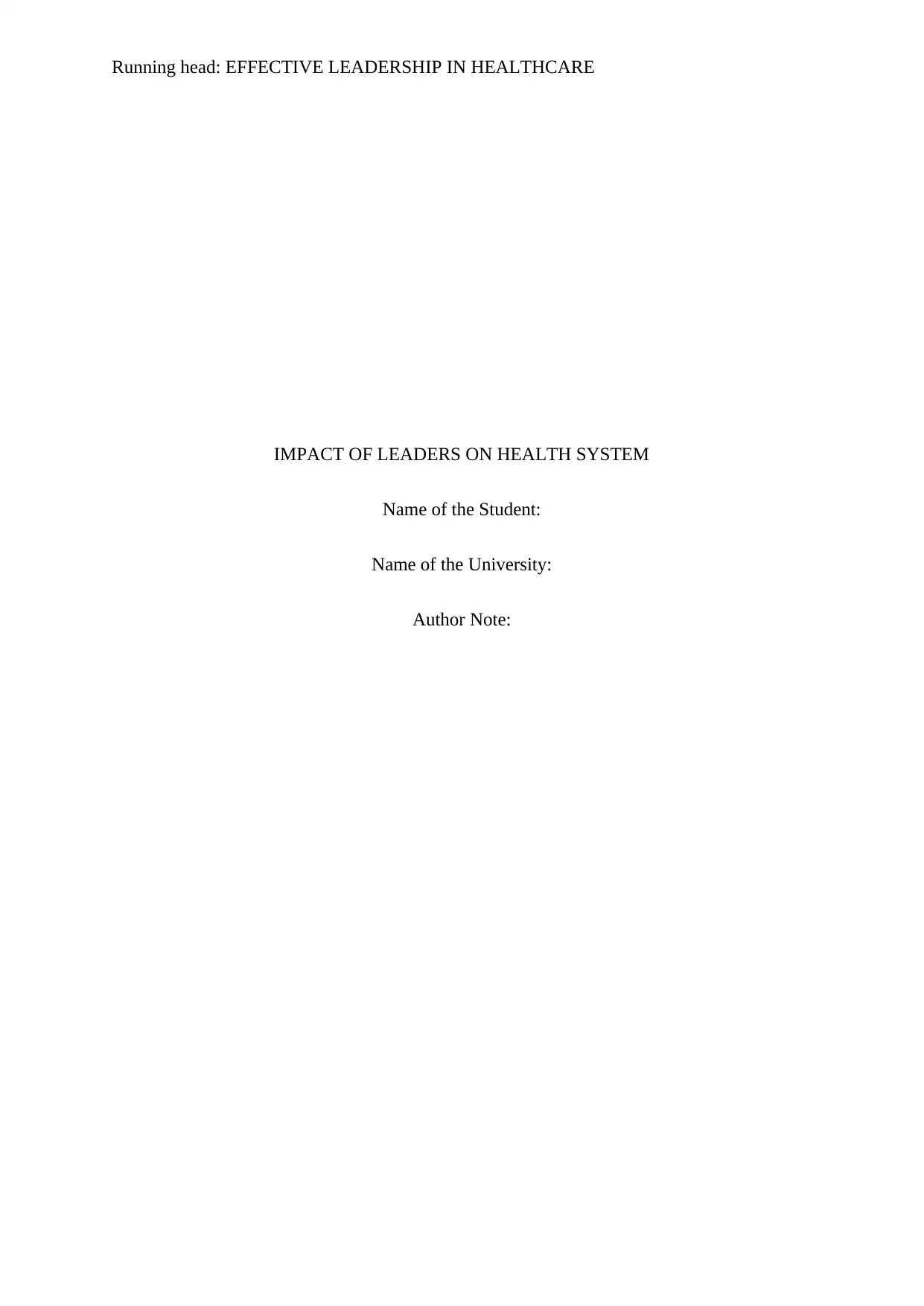
Running head: EFFECTIVE LEADERSHIP IN HEALTHCARE
IMPACT OF LEADERS ON HEALTH SYSTEM
Name of the Student:
Name of the University:
Author Note:
IMPACT OF LEADERS ON HEALTH SYSTEM
Name of the Student:
Name of the University:
Author Note:
Paraphrase This Document
Need a fresh take? Get an instant paraphrase of this document with our AI Paraphraser
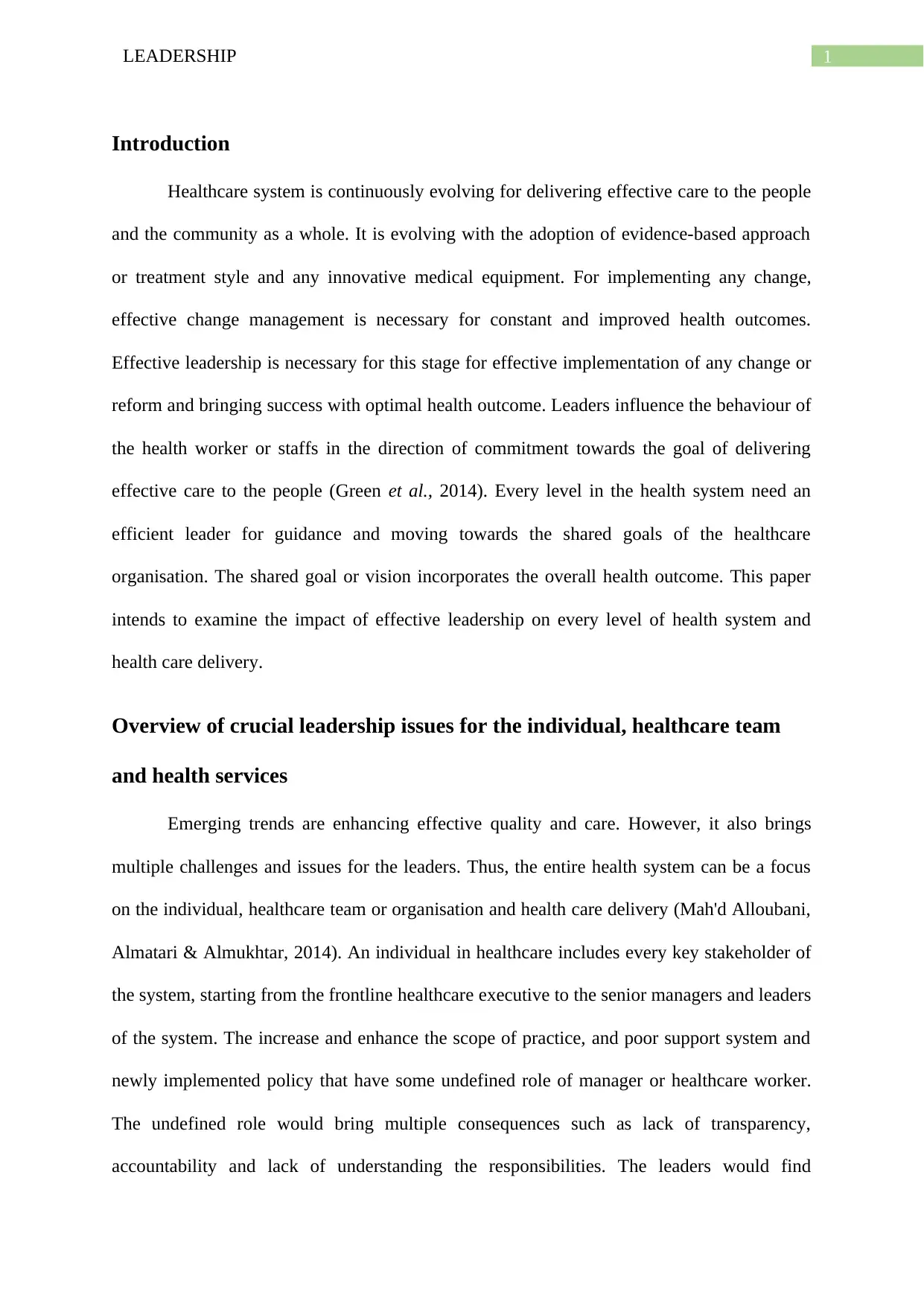
1LEADERSHIP
Introduction
Healthcare system is continuously evolving for delivering effective care to the people
and the community as a whole. It is evolving with the adoption of evidence-based approach
or treatment style and any innovative medical equipment. For implementing any change,
effective change management is necessary for constant and improved health outcomes.
Effective leadership is necessary for this stage for effective implementation of any change or
reform and bringing success with optimal health outcome. Leaders influence the behaviour of
the health worker or staffs in the direction of commitment towards the goal of delivering
effective care to the people (Green et al., 2014). Every level in the health system need an
efficient leader for guidance and moving towards the shared goals of the healthcare
organisation. The shared goal or vision incorporates the overall health outcome. This paper
intends to examine the impact of effective leadership on every level of health system and
health care delivery.
Overview of crucial leadership issues for the individual, healthcare team
and health services
Emerging trends are enhancing effective quality and care. However, it also brings
multiple challenges and issues for the leaders. Thus, the entire health system can be a focus
on the individual, healthcare team or organisation and health care delivery (Mah'd Alloubani,
Almatari & Almukhtar, 2014). An individual in healthcare includes every key stakeholder of
the system, starting from the frontline healthcare executive to the senior managers and leaders
of the system. The increase and enhance the scope of practice, and poor support system and
newly implemented policy that have some undefined role of manager or healthcare worker.
The undefined role would bring multiple consequences such as lack of transparency,
accountability and lack of understanding the responsibilities. The leaders would find
Introduction
Healthcare system is continuously evolving for delivering effective care to the people
and the community as a whole. It is evolving with the adoption of evidence-based approach
or treatment style and any innovative medical equipment. For implementing any change,
effective change management is necessary for constant and improved health outcomes.
Effective leadership is necessary for this stage for effective implementation of any change or
reform and bringing success with optimal health outcome. Leaders influence the behaviour of
the health worker or staffs in the direction of commitment towards the goal of delivering
effective care to the people (Green et al., 2014). Every level in the health system need an
efficient leader for guidance and moving towards the shared goals of the healthcare
organisation. The shared goal or vision incorporates the overall health outcome. This paper
intends to examine the impact of effective leadership on every level of health system and
health care delivery.
Overview of crucial leadership issues for the individual, healthcare team
and health services
Emerging trends are enhancing effective quality and care. However, it also brings
multiple challenges and issues for the leaders. Thus, the entire health system can be a focus
on the individual, healthcare team or organisation and health care delivery (Mah'd Alloubani,
Almatari & Almukhtar, 2014). An individual in healthcare includes every key stakeholder of
the system, starting from the frontline healthcare executive to the senior managers and leaders
of the system. The increase and enhance the scope of practice, and poor support system and
newly implemented policy that have some undefined role of manager or healthcare worker.
The undefined role would bring multiple consequences such as lack of transparency,
accountability and lack of understanding the responsibilities. The leaders would find
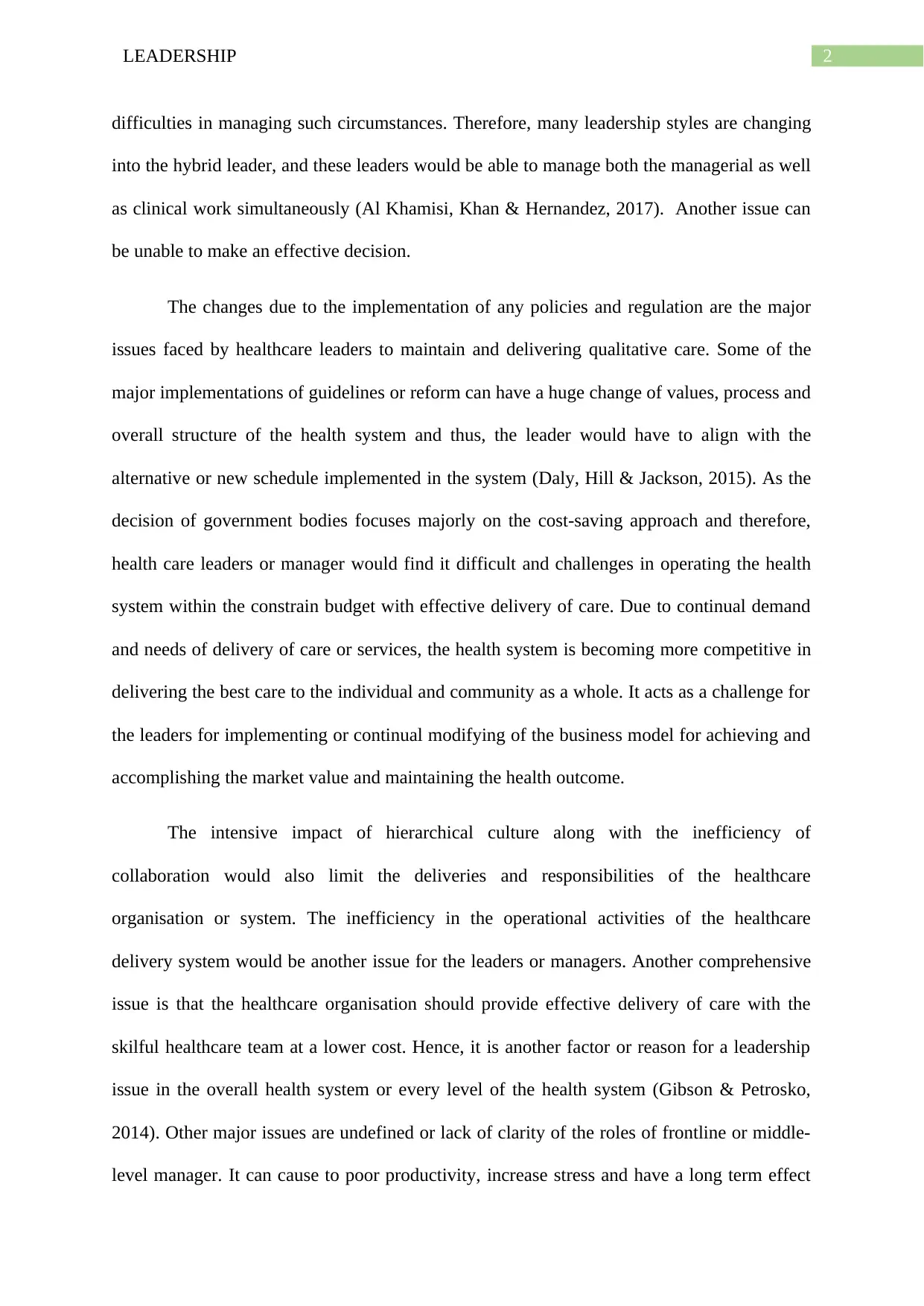
2LEADERSHIP
difficulties in managing such circumstances. Therefore, many leadership styles are changing
into the hybrid leader, and these leaders would be able to manage both the managerial as well
as clinical work simultaneously (Al Khamisi, Khan & Hernandez, 2017). Another issue can
be unable to make an effective decision.
The changes due to the implementation of any policies and regulation are the major
issues faced by healthcare leaders to maintain and delivering qualitative care. Some of the
major implementations of guidelines or reform can have a huge change of values, process and
overall structure of the health system and thus, the leader would have to align with the
alternative or new schedule implemented in the system (Daly, Hill & Jackson, 2015). As the
decision of government bodies focuses majorly on the cost-saving approach and therefore,
health care leaders or manager would find it difficult and challenges in operating the health
system within the constrain budget with effective delivery of care. Due to continual demand
and needs of delivery of care or services, the health system is becoming more competitive in
delivering the best care to the individual and community as a whole. It acts as a challenge for
the leaders for implementing or continual modifying of the business model for achieving and
accomplishing the market value and maintaining the health outcome.
The intensive impact of hierarchical culture along with the inefficiency of
collaboration would also limit the deliveries and responsibilities of the healthcare
organisation or system. The inefficiency in the operational activities of the healthcare
delivery system would be another issue for the leaders or managers. Another comprehensive
issue is that the healthcare organisation should provide effective delivery of care with the
skilful healthcare team at a lower cost. Hence, it is another factor or reason for a leadership
issue in the overall health system or every level of the health system (Gibson & Petrosko,
2014). Other major issues are undefined or lack of clarity of the roles of frontline or middle-
level manager. It can cause to poor productivity, increase stress and have a long term effect
difficulties in managing such circumstances. Therefore, many leadership styles are changing
into the hybrid leader, and these leaders would be able to manage both the managerial as well
as clinical work simultaneously (Al Khamisi, Khan & Hernandez, 2017). Another issue can
be unable to make an effective decision.
The changes due to the implementation of any policies and regulation are the major
issues faced by healthcare leaders to maintain and delivering qualitative care. Some of the
major implementations of guidelines or reform can have a huge change of values, process and
overall structure of the health system and thus, the leader would have to align with the
alternative or new schedule implemented in the system (Daly, Hill & Jackson, 2015). As the
decision of government bodies focuses majorly on the cost-saving approach and therefore,
health care leaders or manager would find it difficult and challenges in operating the health
system within the constrain budget with effective delivery of care. Due to continual demand
and needs of delivery of care or services, the health system is becoming more competitive in
delivering the best care to the individual and community as a whole. It acts as a challenge for
the leaders for implementing or continual modifying of the business model for achieving and
accomplishing the market value and maintaining the health outcome.
The intensive impact of hierarchical culture along with the inefficiency of
collaboration would also limit the deliveries and responsibilities of the healthcare
organisation or system. The inefficiency in the operational activities of the healthcare
delivery system would be another issue for the leaders or managers. Another comprehensive
issue is that the healthcare organisation should provide effective delivery of care with the
skilful healthcare team at a lower cost. Hence, it is another factor or reason for a leadership
issue in the overall health system or every level of the health system (Gibson & Petrosko,
2014). Other major issues are undefined or lack of clarity of the roles of frontline or middle-
level manager. It can cause to poor productivity, increase stress and have a long term effect
⊘ This is a preview!⊘
Do you want full access?
Subscribe today to unlock all pages.

Trusted by 1+ million students worldwide
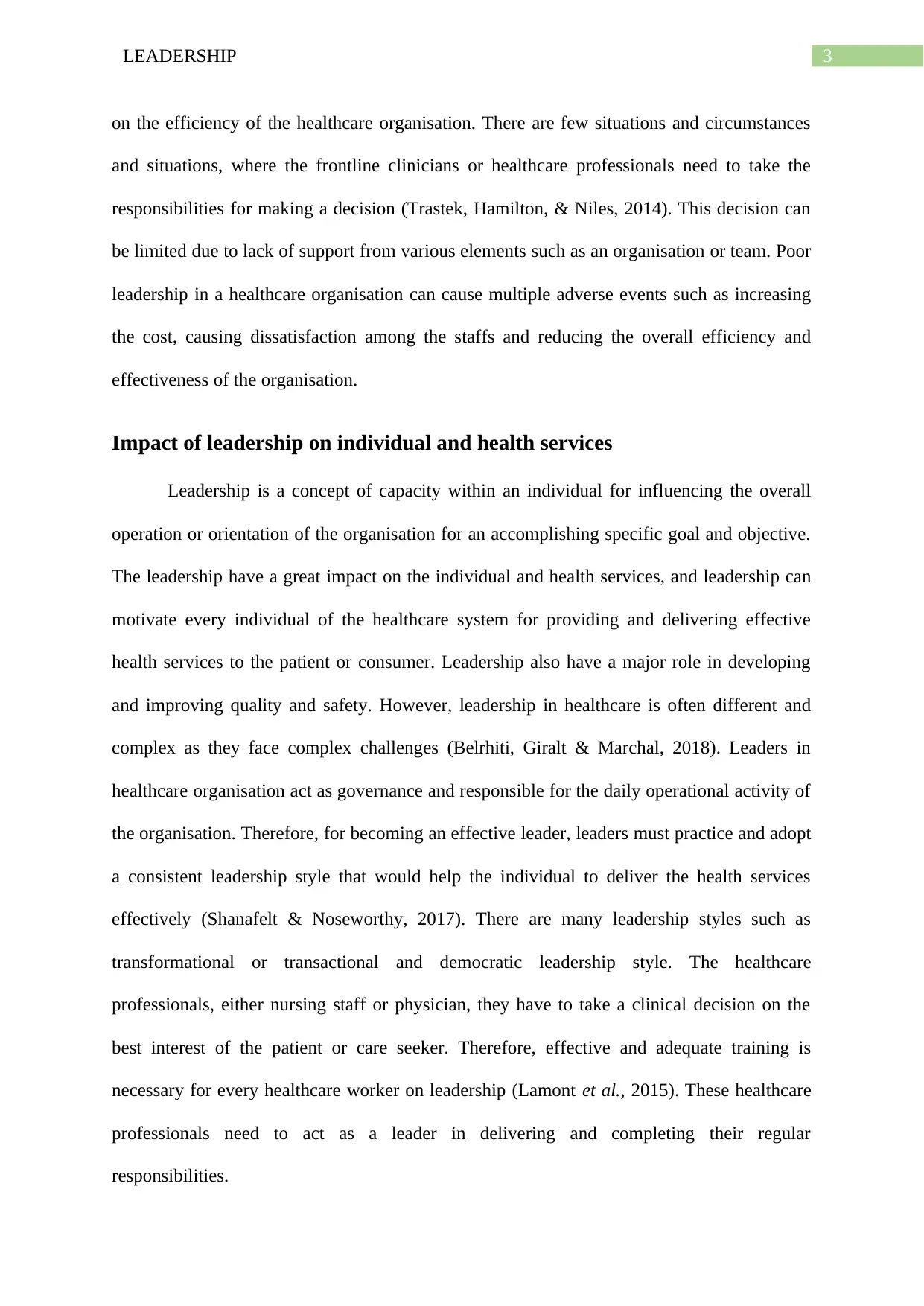
3LEADERSHIP
on the efficiency of the healthcare organisation. There are few situations and circumstances
and situations, where the frontline clinicians or healthcare professionals need to take the
responsibilities for making a decision (Trastek, Hamilton, & Niles, 2014). This decision can
be limited due to lack of support from various elements such as an organisation or team. Poor
leadership in a healthcare organisation can cause multiple adverse events such as increasing
the cost, causing dissatisfaction among the staffs and reducing the overall efficiency and
effectiveness of the organisation.
Impact of leadership on individual and health services
Leadership is a concept of capacity within an individual for influencing the overall
operation or orientation of the organisation for an accomplishing specific goal and objective.
The leadership have a great impact on the individual and health services, and leadership can
motivate every individual of the healthcare system for providing and delivering effective
health services to the patient or consumer. Leadership also have a major role in developing
and improving quality and safety. However, leadership in healthcare is often different and
complex as they face complex challenges (Belrhiti, Giralt & Marchal, 2018). Leaders in
healthcare organisation act as governance and responsible for the daily operational activity of
the organisation. Therefore, for becoming an effective leader, leaders must practice and adopt
a consistent leadership style that would help the individual to deliver the health services
effectively (Shanafelt & Noseworthy, 2017). There are many leadership styles such as
transformational or transactional and democratic leadership style. The healthcare
professionals, either nursing staff or physician, they have to take a clinical decision on the
best interest of the patient or care seeker. Therefore, effective and adequate training is
necessary for every healthcare worker on leadership (Lamont et al., 2015). These healthcare
professionals need to act as a leader in delivering and completing their regular
responsibilities.
on the efficiency of the healthcare organisation. There are few situations and circumstances
and situations, where the frontline clinicians or healthcare professionals need to take the
responsibilities for making a decision (Trastek, Hamilton, & Niles, 2014). This decision can
be limited due to lack of support from various elements such as an organisation or team. Poor
leadership in a healthcare organisation can cause multiple adverse events such as increasing
the cost, causing dissatisfaction among the staffs and reducing the overall efficiency and
effectiveness of the organisation.
Impact of leadership on individual and health services
Leadership is a concept of capacity within an individual for influencing the overall
operation or orientation of the organisation for an accomplishing specific goal and objective.
The leadership have a great impact on the individual and health services, and leadership can
motivate every individual of the healthcare system for providing and delivering effective
health services to the patient or consumer. Leadership also have a major role in developing
and improving quality and safety. However, leadership in healthcare is often different and
complex as they face complex challenges (Belrhiti, Giralt & Marchal, 2018). Leaders in
healthcare organisation act as governance and responsible for the daily operational activity of
the organisation. Therefore, for becoming an effective leader, leaders must practice and adopt
a consistent leadership style that would help the individual to deliver the health services
effectively (Shanafelt & Noseworthy, 2017). There are many leadership styles such as
transformational or transactional and democratic leadership style. The healthcare
professionals, either nursing staff or physician, they have to take a clinical decision on the
best interest of the patient or care seeker. Therefore, effective and adequate training is
necessary for every healthcare worker on leadership (Lamont et al., 2015). These healthcare
professionals need to act as a leader in delivering and completing their regular
responsibilities.
Paraphrase This Document
Need a fresh take? Get an instant paraphrase of this document with our AI Paraphraser
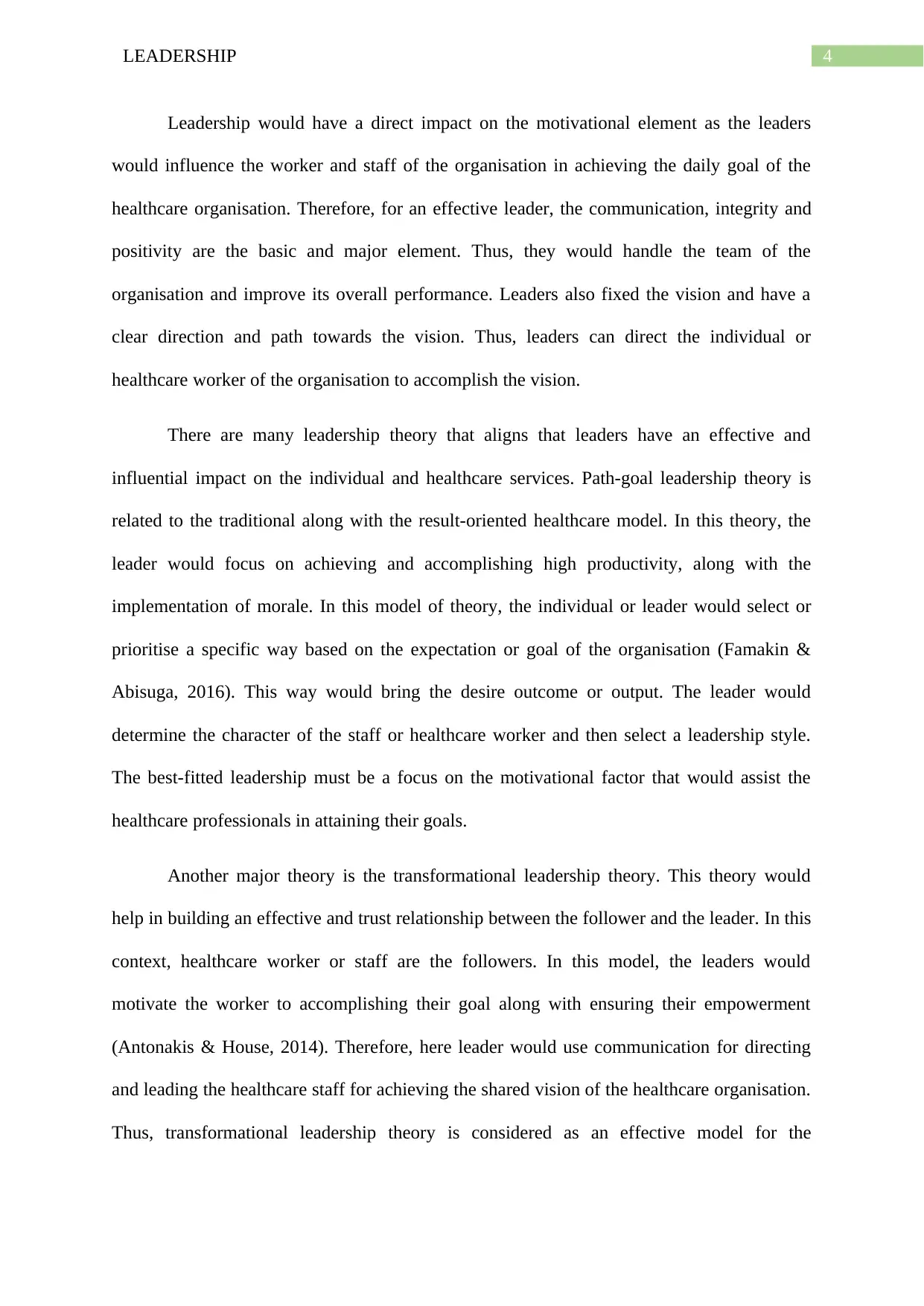
4LEADERSHIP
Leadership would have a direct impact on the motivational element as the leaders
would influence the worker and staff of the organisation in achieving the daily goal of the
healthcare organisation. Therefore, for an effective leader, the communication, integrity and
positivity are the basic and major element. Thus, they would handle the team of the
organisation and improve its overall performance. Leaders also fixed the vision and have a
clear direction and path towards the vision. Thus, leaders can direct the individual or
healthcare worker of the organisation to accomplish the vision.
There are many leadership theory that aligns that leaders have an effective and
influential impact on the individual and healthcare services. Path-goal leadership theory is
related to the traditional along with the result-oriented healthcare model. In this theory, the
leader would focus on achieving and accomplishing high productivity, along with the
implementation of morale. In this model of theory, the individual or leader would select or
prioritise a specific way based on the expectation or goal of the organisation (Famakin &
Abisuga, 2016). This way would bring the desire outcome or output. The leader would
determine the character of the staff or healthcare worker and then select a leadership style.
The best-fitted leadership must be a focus on the motivational factor that would assist the
healthcare professionals in attaining their goals.
Another major theory is the transformational leadership theory. This theory would
help in building an effective and trust relationship between the follower and the leader. In this
context, healthcare worker or staff are the followers. In this model, the leaders would
motivate the worker to accomplishing their goal along with ensuring their empowerment
(Antonakis & House, 2014). Therefore, here leader would use communication for directing
and leading the healthcare staff for achieving the shared vision of the healthcare organisation.
Thus, transformational leadership theory is considered as an effective model for the
Leadership would have a direct impact on the motivational element as the leaders
would influence the worker and staff of the organisation in achieving the daily goal of the
healthcare organisation. Therefore, for an effective leader, the communication, integrity and
positivity are the basic and major element. Thus, they would handle the team of the
organisation and improve its overall performance. Leaders also fixed the vision and have a
clear direction and path towards the vision. Thus, leaders can direct the individual or
healthcare worker of the organisation to accomplish the vision.
There are many leadership theory that aligns that leaders have an effective and
influential impact on the individual and healthcare services. Path-goal leadership theory is
related to the traditional along with the result-oriented healthcare model. In this theory, the
leader would focus on achieving and accomplishing high productivity, along with the
implementation of morale. In this model of theory, the individual or leader would select or
prioritise a specific way based on the expectation or goal of the organisation (Famakin &
Abisuga, 2016). This way would bring the desire outcome or output. The leader would
determine the character of the staff or healthcare worker and then select a leadership style.
The best-fitted leadership must be a focus on the motivational factor that would assist the
healthcare professionals in attaining their goals.
Another major theory is the transformational leadership theory. This theory would
help in building an effective and trust relationship between the follower and the leader. In this
context, healthcare worker or staff are the followers. In this model, the leaders would
motivate the worker to accomplishing their goal along with ensuring their empowerment
(Antonakis & House, 2014). Therefore, here leader would use communication for directing
and leading the healthcare staff for achieving the shared vision of the healthcare organisation.
Thus, transformational leadership theory is considered as an effective model for the
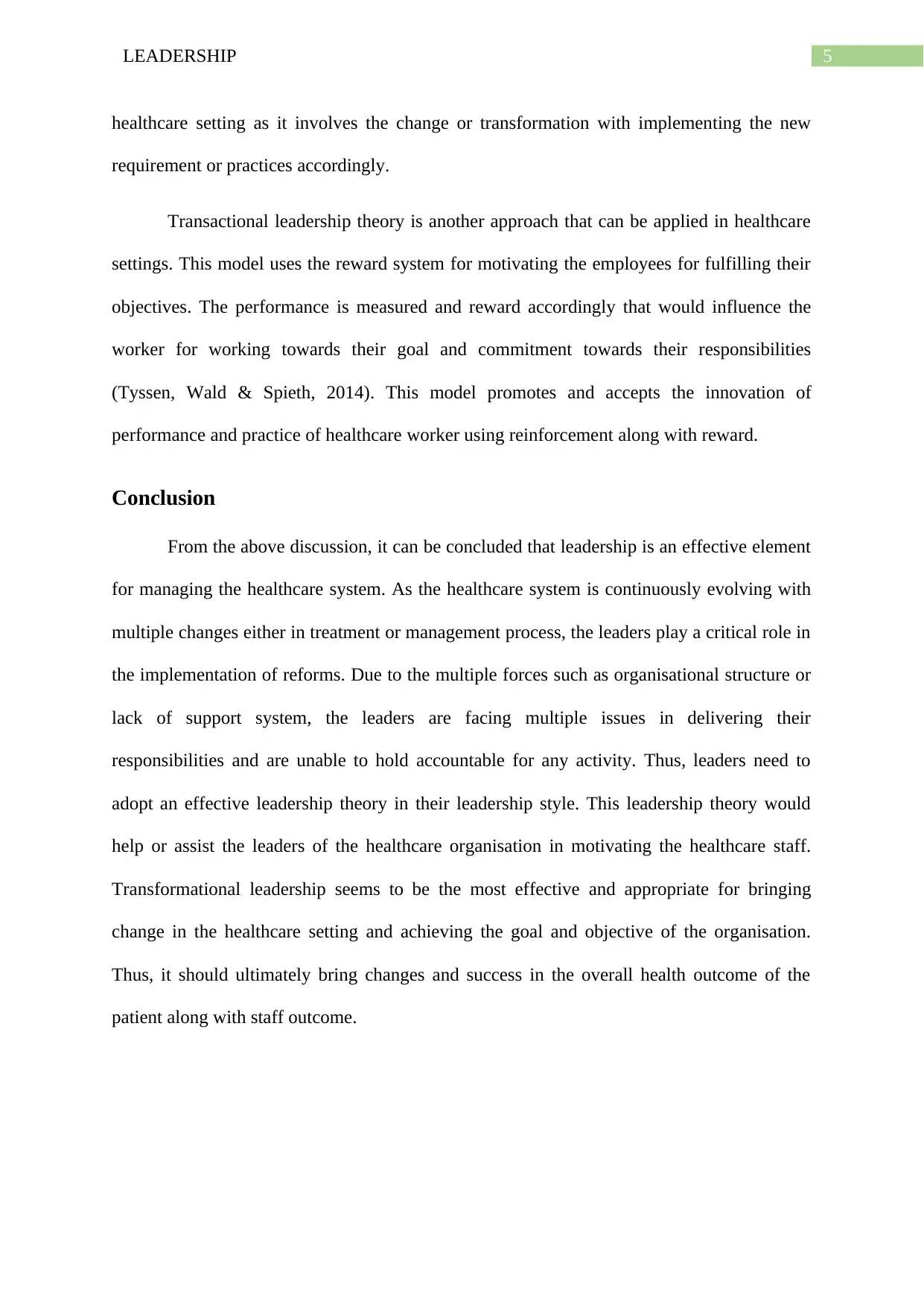
5LEADERSHIP
healthcare setting as it involves the change or transformation with implementing the new
requirement or practices accordingly.
Transactional leadership theory is another approach that can be applied in healthcare
settings. This model uses the reward system for motivating the employees for fulfilling their
objectives. The performance is measured and reward accordingly that would influence the
worker for working towards their goal and commitment towards their responsibilities
(Tyssen, Wald & Spieth, 2014). This model promotes and accepts the innovation of
performance and practice of healthcare worker using reinforcement along with reward.
Conclusion
From the above discussion, it can be concluded that leadership is an effective element
for managing the healthcare system. As the healthcare system is continuously evolving with
multiple changes either in treatment or management process, the leaders play a critical role in
the implementation of reforms. Due to the multiple forces such as organisational structure or
lack of support system, the leaders are facing multiple issues in delivering their
responsibilities and are unable to hold accountable for any activity. Thus, leaders need to
adopt an effective leadership theory in their leadership style. This leadership theory would
help or assist the leaders of the healthcare organisation in motivating the healthcare staff.
Transformational leadership seems to be the most effective and appropriate for bringing
change in the healthcare setting and achieving the goal and objective of the organisation.
Thus, it should ultimately bring changes and success in the overall health outcome of the
patient along with staff outcome.
healthcare setting as it involves the change or transformation with implementing the new
requirement or practices accordingly.
Transactional leadership theory is another approach that can be applied in healthcare
settings. This model uses the reward system for motivating the employees for fulfilling their
objectives. The performance is measured and reward accordingly that would influence the
worker for working towards their goal and commitment towards their responsibilities
(Tyssen, Wald & Spieth, 2014). This model promotes and accepts the innovation of
performance and practice of healthcare worker using reinforcement along with reward.
Conclusion
From the above discussion, it can be concluded that leadership is an effective element
for managing the healthcare system. As the healthcare system is continuously evolving with
multiple changes either in treatment or management process, the leaders play a critical role in
the implementation of reforms. Due to the multiple forces such as organisational structure or
lack of support system, the leaders are facing multiple issues in delivering their
responsibilities and are unable to hold accountable for any activity. Thus, leaders need to
adopt an effective leadership theory in their leadership style. This leadership theory would
help or assist the leaders of the healthcare organisation in motivating the healthcare staff.
Transformational leadership seems to be the most effective and appropriate for bringing
change in the healthcare setting and achieving the goal and objective of the organisation.
Thus, it should ultimately bring changes and success in the overall health outcome of the
patient along with staff outcome.
⊘ This is a preview!⊘
Do you want full access?
Subscribe today to unlock all pages.

Trusted by 1+ million students worldwide
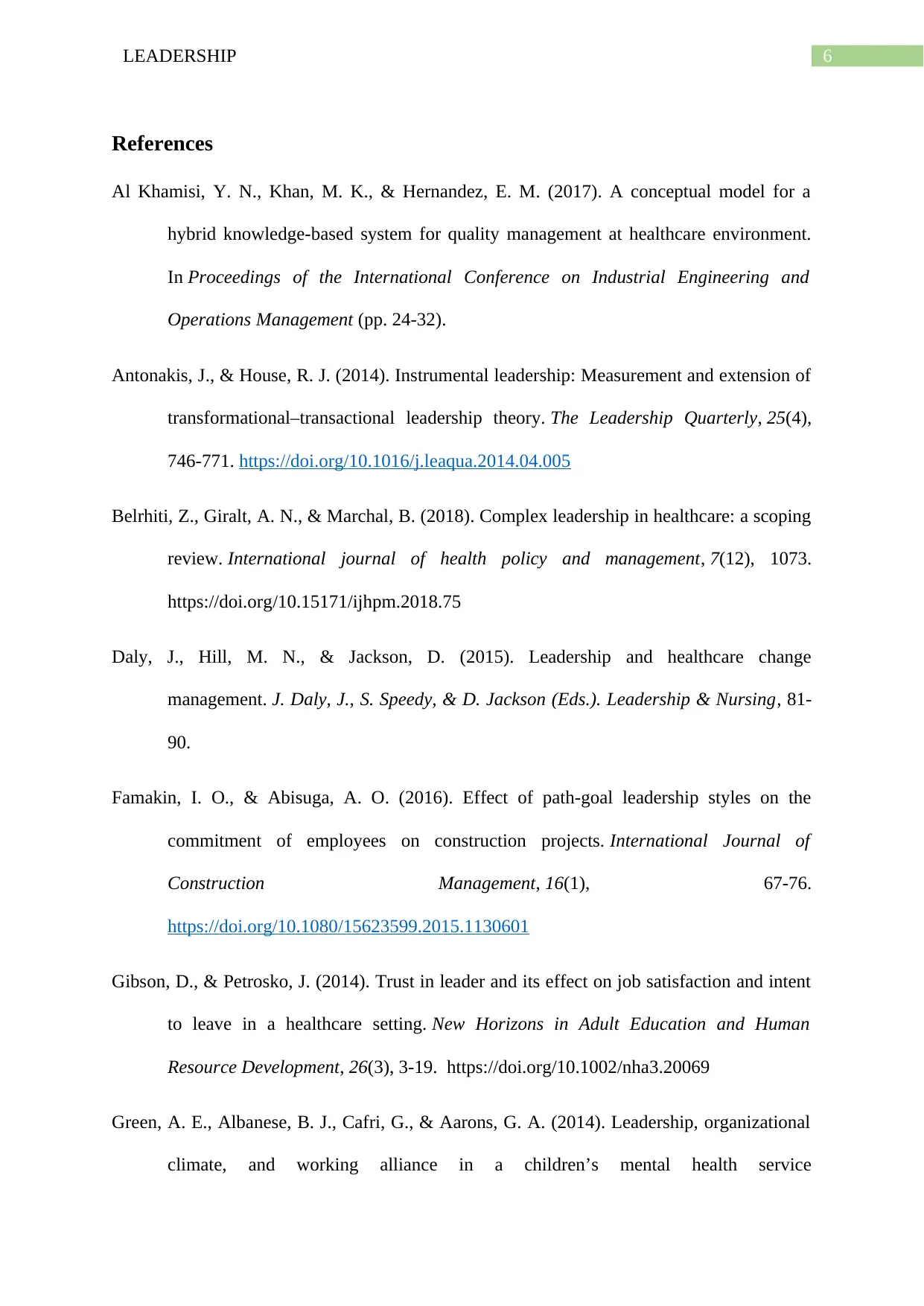
6LEADERSHIP
References
Al Khamisi, Y. N., Khan, M. K., & Hernandez, E. M. (2017). A conceptual model for a
hybrid knowledge-based system for quality management at healthcare environment.
In Proceedings of the International Conference on Industrial Engineering and
Operations Management (pp. 24-32).
Antonakis, J., & House, R. J. (2014). Instrumental leadership: Measurement and extension of
transformational–transactional leadership theory. The Leadership Quarterly, 25(4),
746-771. https://doi.org/10.1016/j.leaqua.2014.04.005
Belrhiti, Z., Giralt, A. N., & Marchal, B. (2018). Complex leadership in healthcare: a scoping
review. International journal of health policy and management, 7(12), 1073.
https://doi.org/10.15171/ijhpm.2018.75
Daly, J., Hill, M. N., & Jackson, D. (2015). Leadership and healthcare change
management. J. Daly, J., S. Speedy, & D. Jackson (Eds.). Leadership & Nursing, 81-
90.
Famakin, I. O., & Abisuga, A. O. (2016). Effect of path-goal leadership styles on the
commitment of employees on construction projects. International Journal of
Construction Management, 16(1), 67-76.
https://doi.org/10.1080/15623599.2015.1130601
Gibson, D., & Petrosko, J. (2014). Trust in leader and its effect on job satisfaction and intent
to leave in a healthcare setting. New Horizons in Adult Education and Human
Resource Development, 26(3), 3-19. https://doi.org/10.1002/nha3.20069
Green, A. E., Albanese, B. J., Cafri, G., & Aarons, G. A. (2014). Leadership, organizational
climate, and working alliance in a children’s mental health service
References
Al Khamisi, Y. N., Khan, M. K., & Hernandez, E. M. (2017). A conceptual model for a
hybrid knowledge-based system for quality management at healthcare environment.
In Proceedings of the International Conference on Industrial Engineering and
Operations Management (pp. 24-32).
Antonakis, J., & House, R. J. (2014). Instrumental leadership: Measurement and extension of
transformational–transactional leadership theory. The Leadership Quarterly, 25(4),
746-771. https://doi.org/10.1016/j.leaqua.2014.04.005
Belrhiti, Z., Giralt, A. N., & Marchal, B. (2018). Complex leadership in healthcare: a scoping
review. International journal of health policy and management, 7(12), 1073.
https://doi.org/10.15171/ijhpm.2018.75
Daly, J., Hill, M. N., & Jackson, D. (2015). Leadership and healthcare change
management. J. Daly, J., S. Speedy, & D. Jackson (Eds.). Leadership & Nursing, 81-
90.
Famakin, I. O., & Abisuga, A. O. (2016). Effect of path-goal leadership styles on the
commitment of employees on construction projects. International Journal of
Construction Management, 16(1), 67-76.
https://doi.org/10.1080/15623599.2015.1130601
Gibson, D., & Petrosko, J. (2014). Trust in leader and its effect on job satisfaction and intent
to leave in a healthcare setting. New Horizons in Adult Education and Human
Resource Development, 26(3), 3-19. https://doi.org/10.1002/nha3.20069
Green, A. E., Albanese, B. J., Cafri, G., & Aarons, G. A. (2014). Leadership, organizational
climate, and working alliance in a children’s mental health service
Paraphrase This Document
Need a fresh take? Get an instant paraphrase of this document with our AI Paraphraser
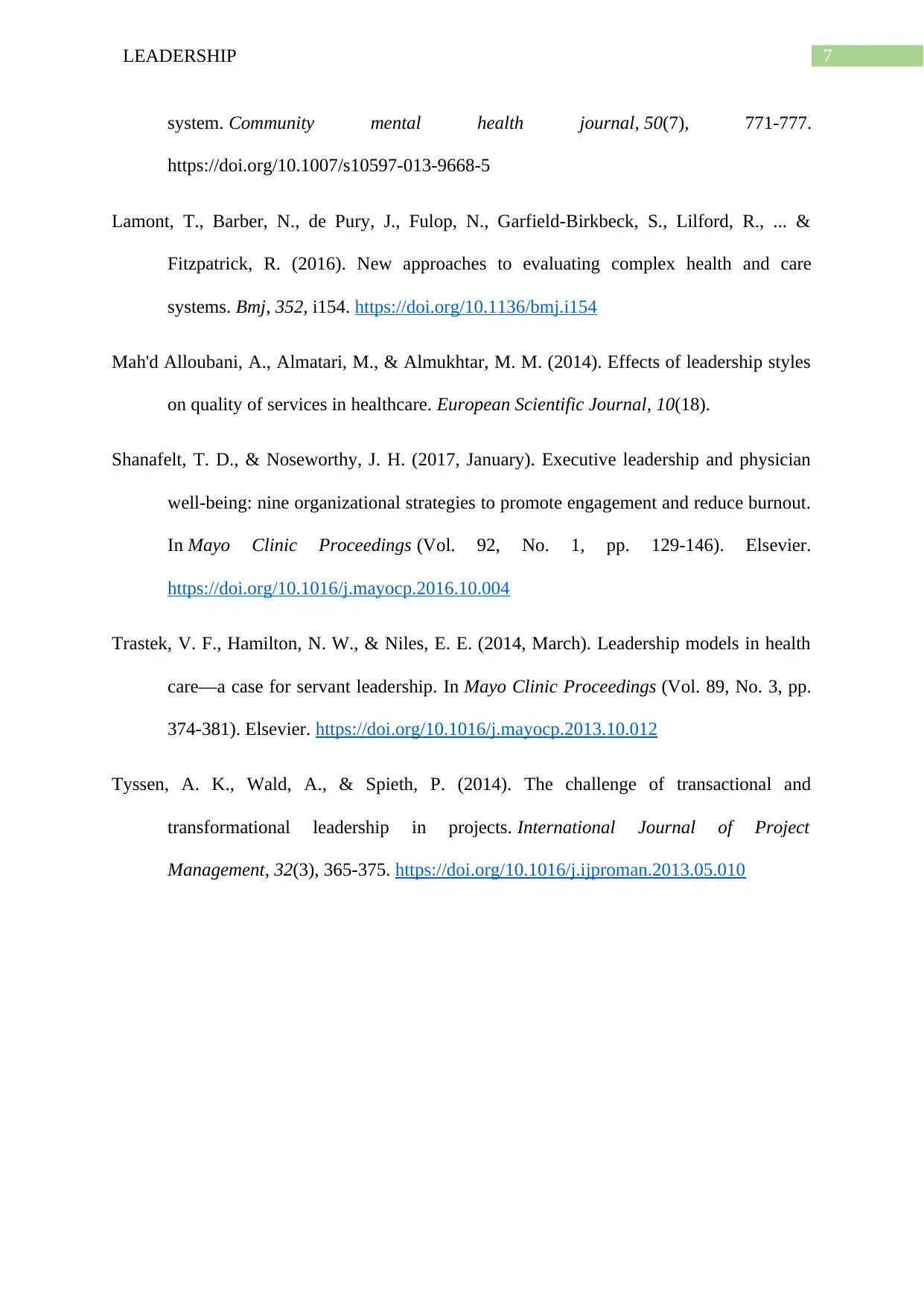
7LEADERSHIP
system. Community mental health journal, 50(7), 771-777.
https://doi.org/10.1007/s10597-013-9668-5
Lamont, T., Barber, N., de Pury, J., Fulop, N., Garfield-Birkbeck, S., Lilford, R., ... &
Fitzpatrick, R. (2016). New approaches to evaluating complex health and care
systems. Bmj, 352, i154. https://doi.org/10.1136/bmj.i154
Mah'd Alloubani, A., Almatari, M., & Almukhtar, M. M. (2014). Effects of leadership styles
on quality of services in healthcare. European Scientific Journal, 10(18).
Shanafelt, T. D., & Noseworthy, J. H. (2017, January). Executive leadership and physician
well-being: nine organizational strategies to promote engagement and reduce burnout.
In Mayo Clinic Proceedings (Vol. 92, No. 1, pp. 129-146). Elsevier.
https://doi.org/10.1016/j.mayocp.2016.10.004
Trastek, V. F., Hamilton, N. W., & Niles, E. E. (2014, March). Leadership models in health
care—a case for servant leadership. In Mayo Clinic Proceedings (Vol. 89, No. 3, pp.
374-381). Elsevier. https://doi.org/10.1016/j.mayocp.2013.10.012
Tyssen, A. K., Wald, A., & Spieth, P. (2014). The challenge of transactional and
transformational leadership in projects. International Journal of Project
Management, 32(3), 365-375. https://doi.org/10.1016/j.ijproman.2013.05.010
system. Community mental health journal, 50(7), 771-777.
https://doi.org/10.1007/s10597-013-9668-5
Lamont, T., Barber, N., de Pury, J., Fulop, N., Garfield-Birkbeck, S., Lilford, R., ... &
Fitzpatrick, R. (2016). New approaches to evaluating complex health and care
systems. Bmj, 352, i154. https://doi.org/10.1136/bmj.i154
Mah'd Alloubani, A., Almatari, M., & Almukhtar, M. M. (2014). Effects of leadership styles
on quality of services in healthcare. European Scientific Journal, 10(18).
Shanafelt, T. D., & Noseworthy, J. H. (2017, January). Executive leadership and physician
well-being: nine organizational strategies to promote engagement and reduce burnout.
In Mayo Clinic Proceedings (Vol. 92, No. 1, pp. 129-146). Elsevier.
https://doi.org/10.1016/j.mayocp.2016.10.004
Trastek, V. F., Hamilton, N. W., & Niles, E. E. (2014, March). Leadership models in health
care—a case for servant leadership. In Mayo Clinic Proceedings (Vol. 89, No. 3, pp.
374-381). Elsevier. https://doi.org/10.1016/j.mayocp.2013.10.012
Tyssen, A. K., Wald, A., & Spieth, P. (2014). The challenge of transactional and
transformational leadership in projects. International Journal of Project
Management, 32(3), 365-375. https://doi.org/10.1016/j.ijproman.2013.05.010
1 out of 8
Related Documents
Your All-in-One AI-Powered Toolkit for Academic Success.
+13062052269
info@desklib.com
Available 24*7 on WhatsApp / Email
![[object Object]](/_next/static/media/star-bottom.7253800d.svg)
Unlock your academic potential
Copyright © 2020–2025 A2Z Services. All Rights Reserved. Developed and managed by ZUCOL.





